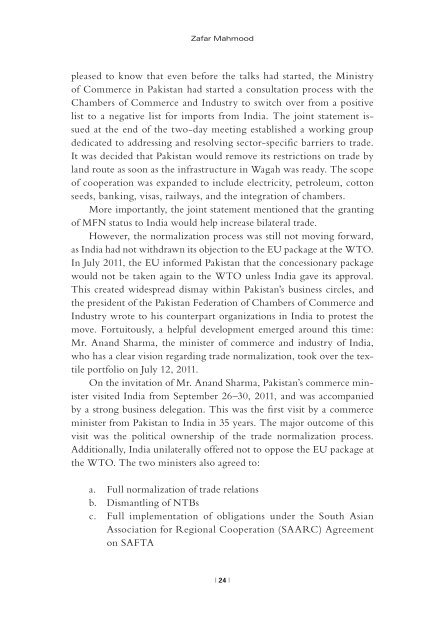Create successful ePaper yourself
Turn your PDF publications into a flip-book with our unique Google optimized e-Paper software.
Zafar Mahmood<br />
pleased to know that even before the talks had started, the Ministry<br />
of Commerce in <strong>Pakistan</strong> had started a consultation process with the<br />
Chambers of Commerce and Industry to switch over from a positive<br />
list to a negative list for imports from <strong>India</strong>. The joint statement issued<br />
at the end of the two-day meeting established a working group<br />
dedicated to addressing and resolving sector-specific barriers to trade.<br />
It was decided that <strong>Pakistan</strong> would remove its restrictions on trade by<br />
land route as soon as the infrastructure in Wagah was ready. The scope<br />
of cooperation was expanded to include electricity, petroleum, cotton<br />
seeds, banking, visas, railways, and the integration of chambers.<br />
More importantly, the joint statement mentioned that the granting<br />
of MFN status to <strong>India</strong> would help increase bilateral trade.<br />
However, the normalization process was still not moving forward,<br />
as <strong>India</strong> had not withdrawn its objection to the EU package at the WTO.<br />
In July 2011, the EU informed <strong>Pakistan</strong> that the concessionary package<br />
would not be taken again to the WTO unless <strong>India</strong> gave its approval.<br />
This created widespread dismay within <strong>Pakistan</strong>’s business circles, and<br />
the president of the <strong>Pakistan</strong> Federation of Chambers of Commerce and<br />
Industry wrote to his counterpart organizations in <strong>India</strong> to protest the<br />
move. Fortuitously, a helpful development emerged around this time:<br />
Mr. Anand Sharma, the minister of commerce and industry of <strong>India</strong>,<br />
who has a clear vision regarding trade normalization, took over the textile<br />
portfolio on July 12, 2011.<br />
On the invitation of Mr. Anand Sharma, <strong>Pakistan</strong>’s commerce minister<br />
visited <strong>India</strong> from September 26–30, 2011, and was accompanied<br />
by a strong business delegation. This was the first visit by a commerce<br />
minister from <strong>Pakistan</strong> to <strong>India</strong> in 35 years. The major outcome of this<br />
visit was the political ownership of the trade normalization process.<br />
Additionally, <strong>India</strong> unilaterally offered not to oppose the EU package at<br />
the WTO. The two ministers also agreed to:<br />
a. Full normalization of trade relations<br />
b. Dismantling of NTBs<br />
c. Full implementation of obligations under the South Asian<br />
Association for Regional Cooperation (SAARC) Agreement<br />
on SAFTA<br />
| 24 |


